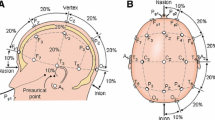Abstract
Electrical signals generated in the brain, known as Electroencephalographic (EEG) signals, form a non-invasive measure of brain functioning. Baseline states of EEG are Eyes Open (EO) and Eyes Closed (EC) relaxed states. The choice of baseline used in an experiment is of critical importance since they form a reference with which other states are measured. In Brain Machine Interface, it is imperative that the system should be able to distinguish between these states and hence the need for automated classification of EEG baselines. In the proposed method, Statistical Moments are utilized. The Moment Generating Functions (MGFs) obtained using these moments are given as features to SVM and k-NN classifiers resulting in mean accuracies of 86.71% and 86.54%. The fact that MGF is able to differentiate between these states indicate that the two states have different source distribution parameters. A Smirnov test verified that the data of two classes indeed come from different distributions.
Access this chapter
Tax calculation will be finalised at checkout
Purchases are for personal use only
Similar content being viewed by others
References
Acharya, U.R., Sree, S.V., Chattopadhyay, S., Suri, J.S.: Automated diagnosis of normal and alcoholic EEG signals. Int. J. Neural Syst. 22(03), 1250011 (2012)
Adeli, H., Ghosh-Dastidar, S., Dadmehr, N.: A wavelet-chaos methodology for analysis of EEGs and EEG subbands to detect seizure and epilepsy. IEEE Trans. Biomed. Eng. 54(2), 205–211 (2007)
Barry, R.J., Clarke, A.R., Johnstone, S.J., Magee, C.A., Rushby, J.A.: EEG differences between eyes-closed and eyes-open resting conditions. Clin. Neurophysiol. 118(12), 2765–2773 (2007)
Bell, M.A., Fox, N.A.: Individual differences in object permanence performance at 8 months: locomotor experience and brain electrical activity. Dev. Psychobiol. 31(4), 287–297 (1997)
Berger, V.W., Zhou, Y.: Kolmogorov-Smirnov test: Overview. Wiley StatsRef: Statistics Reference Online (2005)
Cortes, C., Vapnik, V.: Support-vector networks. Mach. Learn. 20(3), 273–297 (1995)
Ebrahimi, F., Mikaeili, M., Estrada, E., Nazeran, H.: Automatic sleep stage classification based on EEG signals by using neural networks and wavelet packet coefficients. In: 2008 30th Annual International Conference of the IEEE Engineering in Medicine and Biology Society, pp. 1151–1154. IEEE (2008)
Estrada, E., Nazeran, H., Nava, P., Behbehani, K., Burk, J., Lucas, E.: EEG feature extraction for classification of sleep stages. In: 26th Annual International Conference of the IEEE Engineering in Medicine and Biology Society 2004, IEMBS 2004, vol. 1, pp. 196–199. IEEE (2004)
Fleck, J.I., Green, D.L., Stevenson, J.L., Payne, L., Bowden, E.M., Jung-Beeman, M., Kounios, J.: The transliminal brain at rest: baseline EEG, unusual experiences, and access to unconscious mental activity. Cortex 44(10), 1353–1363 (2008)
Goldberger, A.L., Amaral, L.A., Glass, L., Hausdorff, J.M., Ivanov, P.C., Mark, R.G., Mietus, J.E., Moody, G.B., Peng, C.K., Stanley, H.E.: Physiobank, physiotoolkit, and physionet components of a new research resource for complex physiologic signals. Circulation 101(23), e215–e220 (2000)
Janzen, T., Graap, K., Stephanson, S., Marshall, W., Fitzsimmons, G.: Differences in baseline EEG measures for add and normally achieving preadolescent males. Biofeedback Self Regul. 20(1), 65–82 (1995)
Larose, D.T.: K-nearest neighbor algorithm. Discovering Knowledge in Data: An Introduction to Data Mining, pp. 90–106 (2005)
Li, L., Xiao, L., Chen, L.: Differences of EEG between eyes-open and eyes-closed states based on autoregressive method. J. Electron. Sci. Technol. China 7(2), 175–179 (2009)
Miller, S., Childers, D.: Probability and Random Processes: with Applications to Signal Processing and Communications. Academic Press, Cambridge (2012)
Murugappan, M., Ramachandran, N., Sazali, Y., et al.: Classification of human emotion from EEG using discrete wavelet transform. J. Biomed. Sci. Eng. 3(04), 390 (2010)
Schalk, G., McFarland, D.J., Hinterberger, T., Birbaumer, N., Wolpaw, J.R.: BCI 2000: a general-purpose brain-computer interface (BCI) system. IEEE Trans. Biomed. Eng. 51(6), 1034–1043 (2004)
Subasi, A.: EEG signal classification using wavelet feature extraction and a mixture of expert model. Expert Syst. Appl. 32(4), 1084–1093 (2007)
Tan, B., Kong, X., Yang, P., Jin, Z., Li, L.: The difference of brain functional connectivity between eyes-closed and eyes-open using graph theoretical analysis. Computational and mathematical methods in medicine 2013 (2013)
Tzallas, A.T., Tsipouras, M.G., Fotiadis, D.I.: Epileptic seizure detection in EEGs using time-frequency analysis. IEEE Trans. Inf Technol. Biomed. 13(5), 703–710 (2009)
Valenzi, S., Islam, T., Jurica, P., Cichocki, A.: Individual classification of emotions using EEG. J. Biomed. Sci. Eng. 7(8), 604 (2014)
Vijayan, A.E., Sen, D., Sudheer, A.: EEG-based emotion recognition using statistical measures and auto-regressive modeling. In: 2015 IEEE International Conference on Computational Intelligence and Communication Technology (CICT), pp. 587–591. IEEE (2015)
Zhu, G., Li, Y., Wen, P.P., Wang, S.: Analysis of alcoholic EEG signals based on horizontal visibility graph entropy. Brain Inf. 1(1–4), 19–25 (2014)
Author information
Authors and Affiliations
Corresponding author
Editor information
Editors and Affiliations
Rights and permissions
Copyright information
© 2017 Springer International Publishing AG
About this paper
Cite this paper
Gopan K., G., Sinha, N., Babu J., D. (2017). Distribution Based EEG Baseline Classification. In: Mukherjee, S., et al. Computer Vision, Graphics, and Image Processing. ICVGIP 2016. Lecture Notes in Computer Science(), vol 10481. Springer, Cham. https://doi.org/10.1007/978-3-319-68124-5_27
Download citation
DOI: https://doi.org/10.1007/978-3-319-68124-5_27
Published:
Publisher Name: Springer, Cham
Print ISBN: 978-3-319-68123-8
Online ISBN: 978-3-319-68124-5
eBook Packages: Computer ScienceComputer Science (R0)




